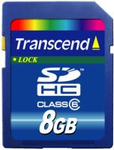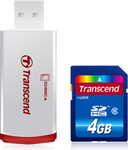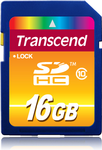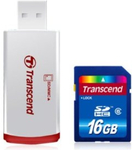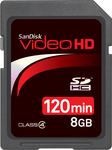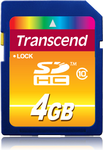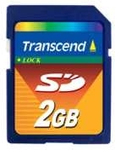Panasonic SD-HC Class 10 Kaart 4GB
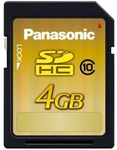
-
Transcend 32GB Secure Digital (SD) Card Class
Link: www.buy.com Transcend's SDHC card is based on the new generation of SD cards (SD 2.0) that support the FAT32 file system format. Fully Class 6 compliant, the card features fast data transfer speeds (guaranteed minimum write speed of 6MB/s) and satisfies the high-capa
-
SDHC Test (Sandisk/IOdata/Toshiba/Panasonic/Transcend/ATP)
Testing Results: Sandisk SDHC Class 2: 17.82 seconds IO Data SDHC Class 2: 11.09 seconds Toshiba SDHC Class 4: 15.01 seconds Panasonic SDHC Class 2: 11.40 seconds Transcend SDHC Class 6: 11.25 seconds ATP ProMax SDHC Class 6: 8.50 seconds Testing Method: The data below was derived by timing how long it took the Nikon D80 to write out 6 RAW images using "continuous shooting" mode. Timing commenced when the camera's card status light illuminated, and stopped when the light went out. All cards were formatted in the camera prior to testing.
-
Bikini International Amateur Prejudging Arnold Classic 2011
March 3, 2011 Columbus, Ohio So many beautiful women from all over the world. Had a great time watching the show. I only had 4gb Panasonic SDHC class 10 so I filled up the card way too fast. I'll be better prepared next time Stay tuned I will try to share highlights from the finals. Camcorder - Panasonic HDC SD600 with Leica zoom Hand held without tripod. Zoom maxed out for most of the shots. Stabilizer worked flawlessly.
-
Sandisk 4GB SDHC Memory Card Class 2 Retail
Sandisk 4GB SDHC Memory Card 4 GB Retail Class 2
-
HD VIDEO TEST with my new Canon T2i 1080p at 30fps.MOV
I took my new Canon EOS T2i / 550D on a field test. Camera did a good job taking full HD 1080p at 30 frames per second. I used a 4GB Kingston SDHC Class 4 card. Basically I wanted to test my memory card how it handles the recording. Honestly, there was no hick ups at all. Though I bought a Panasonic SDHC Class 10 card. Also bought a Kingston 32GB Class 10. I am going to do some more tests and will upload them later. Have a big expectation from the camera. So far so good . . . . .
-
Panasonic 4gb class 10 Olympic edition. snSV9KA168176
Panasonic 4gb class 10 Olympic edition. snSV9KA168176
-
SDHC performance test using Nikon D80
Testing Method: The data below was derived by timing how long it took the Nikon D80 to write out 6 RAW images using "continuous shooting" mode. Timing commenced when the camera's card status light illuminated, and stopped when the light went out. All cards were formatted in the camera prior to testing. Testing Environment: Nikon D80 Testing Results: Panasonic SDHC Class 2: 12 seconds Toshiba SDHC Class 4: 15 seconds Transcend SDHC Class 6: 12 seconds ATP ProMax SDHC Class 6: 8 seconds
-
Canon 550D test with SANDISK SDHC Extreme Card
www.pureprintstraining.co.uk The canon 550D need the right SDHC card for it to function at its full potential. The Sandisk SDHC Extreme 20MB/S card works great with the 550D. This video shows you a demonstartion of why I have switched SDHC cards to the extreme.
-
SHDC 16 GB Class 10 von MemoryStar - Review - Feedback - aykut.me
Lesegeschwindigkeit: ca. 17 MB/Sek (durch ein Test ermittelt worden) Schreibgeschwindigkeit ca. 10-11 MB/Sek (durch das Laden von Daten auf die Karte ermittelt worden) 10 Jahre Garantie ! Sehr gute Karte - hält was es verspricht, auch wenn es keine teure Panasonic, SanDisc usw ist. Bitte beachtet, dass es sich hierbei um eine Class 10 handelt. Für 35 € und billiger kriegt man auch andere 16GB Karten aber dieses sind meistens kleiner als Class 4 Also auf gut die hälfte langsamer...
-
High-Speed Speicherkarten-Adapter SD/SDHC auf CF Quenox - by www.enjoyyourcamera.com
www.enjoyyourcamera.com Quenox High-Speed SDHC, SD UDMA Adapter auf CF-Card SD-Speicherkartenadapter für CF-Kartenslots Mit dem Quenox SD/CF-Adapter lassen sich SD-Karten auch in einem CF-Kartenslot nutzen, zB in Spiegelreflexkameras, Kartenlesegeräten, Computern, uvm. Das High-Speed CF-Interface unterstützt dabei die volle Geschwindigkeit der eingelegten SD-Karte. * Adapter für die Nutzung von SD-Karten (SD, MMC, SDHC) in DSLR-Kameras mit CF-Kartenslot * UDMA High-Speed Interface * Volle SD-Karten-Geschwindigkeit * Plug & Play - Einfach SD-Karte einsetzen und fertig ist die adaptierte CF-Karte * MicroSD, MiniSD werden mit SD-Adapter ebenfalls unterstützt Technische Details: CF-Modul: Compact Flash Type II (True IDE Mode / IO Mode / Memory Mode) Kompatibel mit Windows, Mac OS und Linux Größe: 42,8 x 36,4 x 5,0mm Gewicht: ca. 10g Kompatibilität: SDHC: 4-32GB Class 1-10 SD: 8MB-2GB Class 1-10 miniSDHC: 4-32GB Class 1-10 (zusätzlicher SD-Adapter benötigt) miniSD: 8MB-2GB Class 1-10 (zusätzlicher SD-Adapter benötigt) microSDHC: 4-32GB Class 1-10 (zusätzlicher SD-Adapter benötigt) microSD: 8MB-2GB Class 1-10 (zusätzlicher SD-Adapter benötigt) SD 3.0 Card (SDXC): Größer als 32GB (getestet mit Panasonic 48GB SDXC & Sandisk 64GB SDXC)
-
Panasonic Lumix DMC-TZ7 Beeping in Video
I think the Lumix TZ7 has a general problem with fast SDHC cards. Listen to the video... Sandisk Extreme III 16 GB = as shown in Video Sandisk Extreme III 8GB = less, but still there if quiet Apacer 150x Hispeed SD 2GB = as shown in Video Panasonic SDHC 16GB Class 6 (goldig) = as shown in Video Lexar Standard SDHC 8GB (Class 2....) = perfect , no beeping Lexar Standard SDHC 4GB (Class 2....) = perfect , no beeping Firmware 1.1. Did test with 4 cameras. All of them have the same problem.
-
CANON EOS 5D MARK II SDHC-CF ADAPTER CARD TEST
1. CF CARD SanDisk Extreme IV UDMA 4GB CF CARD 2.SDHC-CF ADAPTER CARD Panasonic SD/SDHC ADAPTER CARD With Transcend SDHC Class6 8GB CARD
-
A-Data SDHC 16GB Turbo (class6) flash card Complaint
Here I show how this class6 flash card is incapable of recording video with a Panasonic DMC-TZ5. This problems occurs while in 720p mode, as well as the lower quality modes like 848x480. For more information, be sure to check my website over at: www.DanFra.net
-
Does Name Brand Matter?: Transcend Vs. Sandisk Extreme
Comparing an expensive memory card and the generic name brand card. do you see a difference?
-
TheTechnoFlip: Nikon D3100 DSLR camera Kit Unboxing
I brought this camera Nikon D3100 with 18-55mm kit lens from letsbuy dot com , along with this I also got free gifts like tripod, DSLR bag, 16GB 10 class SCHC card, 4GB SDHC card( worth 5K)
-
1080p Kodak Playsport withPanasonic 4GB Class 10 SD Card
Awesome camera!
-
Early 2011 Macbook Pro will not read Sandisk Extreme Class 10 16gb SD Card
*UPDATE 28th June 2011* - Seems like the problem has been resolved with the new 10.6.8 update. It can take awhile, at least 10 seconds at times, for the card to be detected, but at least it now works! Thanks to Houdini528 for highlighting it! If you're still having problems please share so others are aware. Cheers! ----------------------------- I have this problem which is quite frustrating. I recently purchased a 15 inch 2011 MBP 2.2ghz i7 and everything's great, except for that I'd also recently bought a Sandisk 16gb Extreme SDHC Class 10 SD Card, and it can't seem to be read on the new laptop!!! It works through an external reader, it also works on older versions of MBPs and iMacs. At times, for some reason, it works on the new laptop too! I understand that the new SD Card Readers for the 2011 MBPs are wired through PCIE, unlike the older models which are wired through a USB port on the chipset...could this be affecting the problem? Apple please resolve this soon, Sandisk won't (and shouldn't) take back the card because there's nothing wrong with it. *I don't have a video here, but the card also faces the same problem on 2 other early 2011 MBPs I've tested them on, so I doubt it's just my laptop that's acting up.
-
SIG TV - Panasonic 4GB Class 10 SDHC UHS-1 90MB/s Memory Card (Proof 5)
One of the requirements for SD memory cards with high capacity is a highly reliable data save function. Panasonic's SD memory cards include our unique Intelligent Controller to provide longer life and greater reliability. It keeps your important data safe under a wide range of usage conditions and potential accident situations. Improved construction (Proof 5) - Waterproof, Shockproof, Magnetproof, X-Ray proof, Extreme temperature proof Extreme bending/twisting - guaranteed to be 2x stronger than the industry's minimum specifications Made in Japan
-
Micro SD Karte
microSD ist ein ausgesprochen kompaktes Flash-Speicherkarten-Format, welches elektrisch mit SD Memory Card identisch ist. Die Zusatzbezeichnung microSDHC definiert Größenordnungen bis zu 32 GB und micro SDXC bis hin zu 2 TB. Wie auch die SD Card wird die microSD seitens der SD Association nach Standards lizenziert. Beschaffenheit micro SD Karten sind mittels der Größe von 11 mm × 15 mm × 0,7 mm sehr kompakt wie auch leichtgewichtig (0,4 g). Sie sind in Kapazitäten von 16 MB bis 64 GB erhältlich. Das neue 64-GB-Modell hält mit sagenhaften 554 GB/cm3 den Rekord an Speicherdichte. Da microSD Karten im Großen und Ganzen SD-Speicherkarten mit verkleinertem Gehäuse sind, gelten für sie dieselben Spezifikationen. Deshalb existieren gleichermaßen zu SDHC- fernerhin microSDHC-Karten mit Kapazitäten ab 4 GB aufwärts und einer Einordnung in Geschwindigkeitsklassen. Ursprung Das microSD-Format wurde zu anfang seitens SanDisk zusammen mit der Bezeichnung T-Flash, ab jetzt TransFlash, entwickelt. Bei der Annahme durch die SD Card Association (SDA), einer Interessengemeinschaft der Firmen Panasonic, SanDisk und Toshiba, wurde es schließlich im Juli 2005 in microSD umbenannt. Verwendung microSD-Karten werden angesichts ihrer kleinen Abmessungen sowie ihres geringen Gewichts meist in vielen mobilen Endgeräten wie z. B. in Smartphones verwendet. Der Einsatz richtet sich entsprechend dem zunehmenden Speicherbedarf von seiten Mobiltelefonen oder Smartphones. Darum ist es anhand micro SD <b>...</b>
-
How To Pick an SD Memory Card
Watch more Data Management & Storage videos: www.howcast.com Subscribe to Howcast's YouTube Channel - howc.st Pick an SD memory card that fits your needs by following this advice. Howcast uploads the highest quality how-to videos daily! Be sure to check out our playlists for guides that interest you: howc.st Subscribe to Howcast's other YouTube Channels: Howcast Health Channel - howc.st Howcast Video Games Channel - howc.st Howcast Tech Channel - howc.st Howcast Food Channel - howc.st Howcast Arts & Recreation Channel - howc.st Howcast Sports & Fitness Channel - howc.st Howcast Personal Care & Style Channel - howc.st Howcast empowers people with engaging, useful how-to information wherever, whenever they need to know how. Emphasizing high-quality instructional videos, Howcast brings you experts who provide accurate information in easy-to-follow tutorials on everything from makeup, hairstyling, nail art design, and soccer to parkour, skateboarding, dancing, kissing, and much, much more. Step 1: Check compatibility Check the compatibility of older digital cameras or camcorders to the newer SDHC that have become the standard over the old SD cards. Step 2: Determine size Determine how much storage space you need. If you are buying an SD card for a still camera, a 4 GB card is sufficient. For video, 8 or 16 GB is needed. Step 3: Pick a speed Assess your need for speed. Stated speed is how fast still images are written to a card, whereas Class ratings are how fast video is <b>...</b>






















